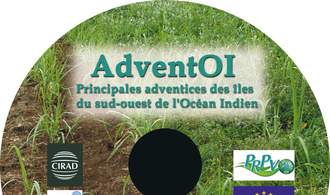Identifying weeds in the Indian Ocean: AdventOI
Written by Modified on the
Launching
- Install the AdventOI.zip (10 Mo) on your hard disk.
- Click on Install.exe ; the software will by default install itself in a Cirad directory.
- Launch the software by clicking on « Démarrer », « Tous les programmes », « Cirad », «AdventOI ».
- Open « Aller à ...» then « Options » then « Répertoires » ; click on « Site Web Adresses ».
- Copy the address where the software will look automatically for the species descriptive files : http://www.prpv.org/advenrun/especes/
Realisation
Cirad, Service de Protection des Végétaux, Réunion
Authors
Thomas Le Bourgeois, Eric Jeuffrault, Pierre Grard, Alain Carrara
The identification process
The identification principle used by AdventOI consists in the construction, step by step, of the morphological characteristics of the plant to be identified. The diagram of a theoretical plant shows on the screen all variations of the characters (root, stem, hairiness, leaf, different parts of the leaf, habit / bearing, ...). As from the diagram, the user will describe the characters which seem to him the most interesting and which allows him to say that this species is different from other species. The user is free to choose the characters for the description..
The description of each of those characters is done in a graphic way, without technical terminology. For each character, the software proposes a choice of variations among which the user must choose the one appropriate to his sample.
At any moment a character already described can be modified while keeping all the information about the other characters already described.
At each step of the identification, a coefficient of similarity is calculated for all species known by the software. They are then sorted out in decreasing order of similarity (results button).
In case of indecision as to the choice of the character to be described, the user ca ask the software to propose the most relevant character allowing to sort out the group of species having the highest coefficient of similarity (research button).
When a species is identified with less than 100% of similarity, the profiler indicates the characters not properly described (button with the red flash).
For each species and at any moment of the identification process, the user can access to its description. He can thus more rapidly compare the description of 4 or 5 species having the highest coefficients of similarity instead of continuing his description of other characters till only one species remains on top of the list.
This system introduces a great flexibility and an important easiness in the use of the software. It tolerates lack of information (incomplete samples), errors of observation (ambiguities automatically managed). A species is always identifiable, even when a character is badly described. It then has a coefficient of similarity of less than 100%.
The description of species
The description sheets of the species are generated as html pages. They can be reached either directly from the CD-ROM or from a shared hard-disk, an intranet or internet server. Each species is named after its valid name and its most current synonyms, as well as by its vernacular names. The species is fully described, from the seedling to the seed, emphasizing the vegetative characters so as to facilitate the recognition of incomplete samples. In that description, all technical terms are backed by an illustrated definition in hypertext. Each description includes several colour pictures of the plant, the seedling or details together with a botanic drawing. Information on the ecology and the agronomic importance of the species for local crops are also mentioned
Those descriptive sheets can be reached either from the identification system through the list of species classified for their similarity with the description, or directly from a list of species sorted out as from the families, the scientific or vernacular names.


